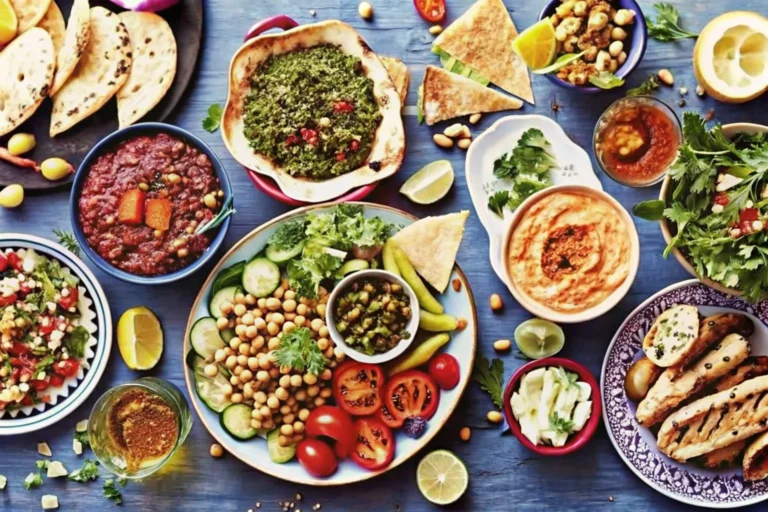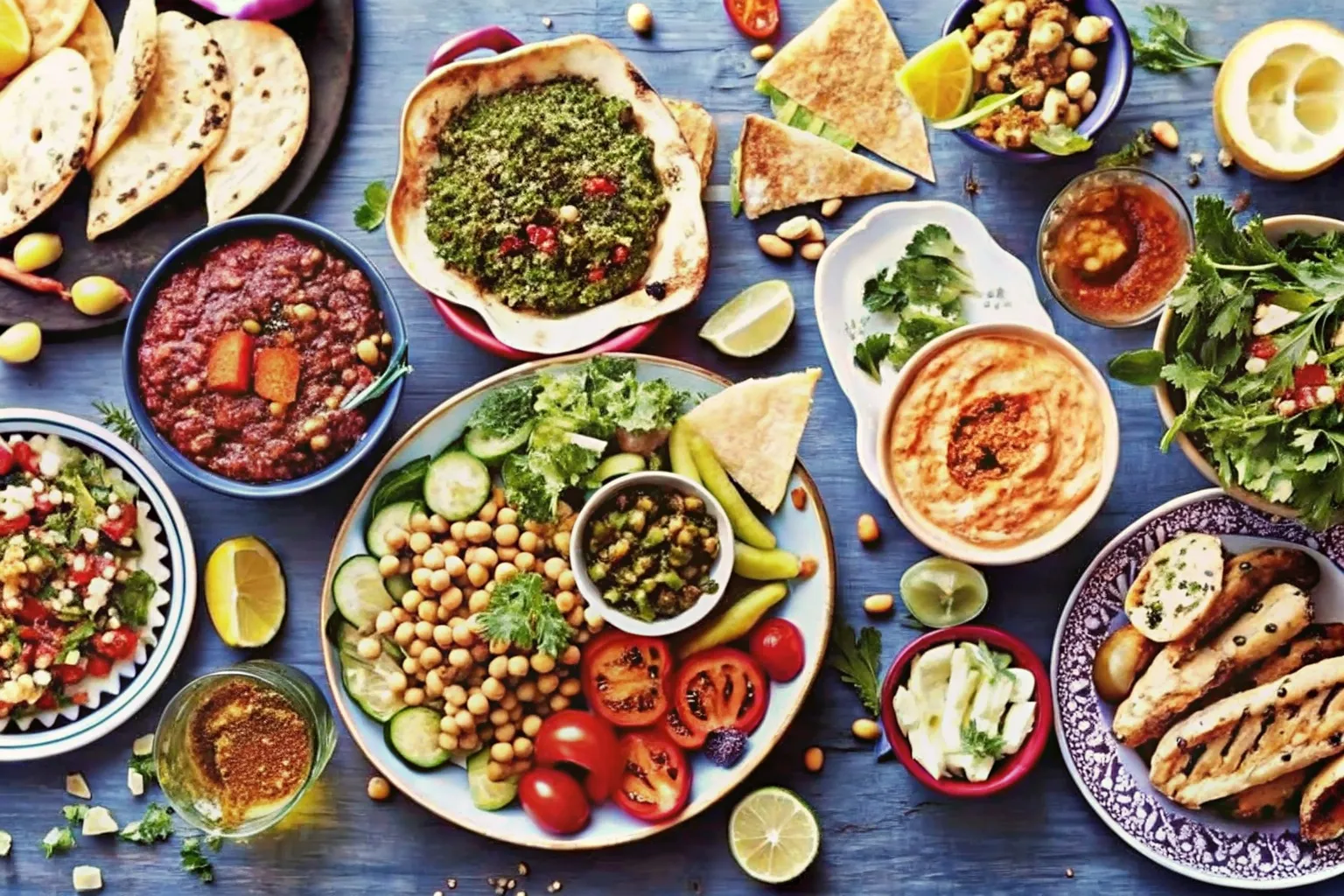Introduction
A mezze platter is a vibrant, flavorful spread of small dishes and appetizers originating from the culinary traditions of the Middle East and the Mediterranean. Derived from the Persian word “mazzeh,” meaning “taste” or “snack,” mezze encompasses a variety of textures, flavors, and colors. Perfect for entertaining, this style of eating encourages grazing, sharing, and lively conversation around the table.
Creating a mezze platter is as much about presentation as it is about taste. With a thoughtful selection of dips, spreads, breads, vegetables, cheeses, and garnishes, you can craft a visually stunning and delicious centerpiece for any gathering. Mezze is flexible and forgiving, allowing you to build it according to personal taste, dietary needs, and seasonal availability. This guide will walk you through building the perfect mezze platter, offering tips, variations, and ideas to customize your spread to suit any occasion.
What Is Mezze?
Mezze is a collection of small plates typically served at the beginning of a meal throughout the Eastern Mediterranean, the Levant, and parts of the Middle East. Similar in spirit to Spanish tapas or Italian antipasti, mezze dishes can be served hot or cold, and they often highlight local, seasonal ingredients.
Unlike a single appetizer, a mezze platter brings together a variety of complementary dishes, giving guests a range of flavors to explore. Whether it’s creamy hummus, smoky baba ghanoush, or a refreshing tabbouleh salad, mezze invites you to taste a little bit of everything. It’s a culinary experience meant to stimulate the appetite and foster communal enjoyment around the table.
Why a Mezze Platter Is Perfect for Entertaining
There’s something incredibly inviting about a mezze platter. Here’s why it works so well for gatherings:
- Variety: With multiple items on one platter, there’s something for everyone—perfect for accommodating different dietary preferences, including vegetarian, vegan, and gluten-free options.
- Visual appeal: Mezze is naturally colorful and vibrant, making for an eye-catching centerpiece that adds life to any table.
- Make-ahead friendly: Many mezze components can be prepared in advance, allowing you to enjoy your party instead of working in the kitchen.
- Interactive and communal: Sharing food enhances conversation and connection, making mezze ideal for social settings. It invites guests to engage with the food and with one another.
Essential Components of a Mezze Platter
Here’s a breakdown of the key components that go into a traditional yet flexible mezze platter:
1. Dips and Spreads
Dips are the heart of a mezze platter. Choose at least two or three:
- Whipped Feta: Creamy, tangy, and often blended with lemon zest, honey, and fresh herbs like dill or oregano.
- Muhammara: A Syrian dip made from roasted red peppers, walnuts, garlic, and pomegranate molasses.
- Hummus: A classic chickpea and tahini dip—consider variations like roasted garlic, sun-dried tomato, or beet hummus.
- Baba Ghanoush: A smoky eggplant spread with tahini, garlic, lemon juice, and olive oil.
- Labneh: Strained yogurt that is thick, tangy, and often topped with za’atar, olive oil, or a drizzle of honey.
- Taramosalata: A Greek dip made with fish roe, olive oil, and lemon—perfect for those who enjoy bold flavors.
2. Grains and Salads
A fresh salad or grain-based dish adds brightness and texture:
- Tabbouleh: A parsley and bulgur salad with tomatoes, cucumber, and lemon juice. It’s fresh, zesty, and herbaceous.
- Couscous Salad: Tossed with herbs, chickpeas, chopped dried apricots, pine nuts, and a cumin-laced vinaigrette.
- Quinoa with Lemon and Mint: A gluten-free option that pairs well with Mediterranean flavors and can be served chilled.
- Lentil Salad: Green or black lentils tossed with red onion, cherry tomatoes, and a lemon vinaigrette.
3. Breads and Crackers
Offer items for dipping and scooping:
- Pita Bread: Warm, fluffy, and perfect for tearing into pieces.
- Pita Chips: Crunchy and ideal for thicker dips like muhammara or hummus.
- Lavash or Flatbreads: Thin, soft breads that complement spreads and cheeses.
- Seeded Crackers or Grissini: Adds variety and crunch for guests who prefer a crisp bite.
4. Fresh Vegetables
For dipping or just snacking:
- Cherry Tomatoes: Juicy, sweet, and beautiful on a platter.
- Persian Cucumbers: Crisp, refreshing, and less watery than English cucumbers.
- Radishes: Peppery and crunchy; slice or quarter them for easy handling.
- Carrot Sticks or Bell Pepper Strips: Provide color and texture. Try rainbow carrots or multicolored peppers for visual flair.
- Endive Leaves: A great alternative to chips—slightly bitter and perfect for scooping dips.
5. Briny and Tangy Accents
These add a burst of flavor and contrast:
- Kalamata and Green Olives: Choose a mix of textures and colors. Marinated olives with herbs or citrus zest add even more flavor.
- Pickled Vegetables: Such as pickled turnips, red onions, or pickled cauliflower for crunch and acidity.
- Artichoke Hearts: Halved or quartered, marinated in olive oil and herbs.
- Pepperoncini or Other Mild Pickled Peppers: Adds tang and heat.
- Capers or Cornichons: Small touches that can elevate the entire board.
6. Cheeses
Include at least one variety, or create a small cheese corner:
- Feta Cheese: Cubed or crumbled, sometimes marinated with olive oil, oregano, and red pepper flakes.
- Halloumi: Grilled and sliced into fingers or wedges. Salty and chewy.
- Goat Cheese or Ricotta: For a softer, milder option. Consider drizzling honey or sprinkling za’atar on top.
- Kasseri or Manouri: Traditional Mediterranean cheeses that add character to your platter.
7. Fruits and Garnishes
Add freshness and contrast:
- Lemon Wedges: A squeeze of lemon brightens everything.
- Fresh Mint and Parsley: Use as sprigs for garnish or chopped over the top for extra flavor.
- Pomegranate Seeds or Grapes: Offer sweetness and a burst of color.
- Figs or Dates: Add a rich, chewy sweetness to balance savory items.
- Roasted Nuts: Almonds, pistachios, or walnuts provide crunch and earthiness.
How to Assemble a Mezze Platter
- Start with a Large Platter or Board: Use a wide, shallow platter, cutting board, slate, or even a baking tray.
- Place the Bowls First: Add small bowls or ramekins for dips and wet items like olives, artichokes, or marinated cheese.
- Layer in Larger Items: Fan out sliced vegetables, arrange stacks of bread, and place cheeses strategically.
- Fill in Gaps with Color and Texture: Use herbs, lemon wedges, dried fruit, or roasted nuts to fill in any bare spots.
- Balance and Flow: Arrange items so each type of flavor and texture is evenly distributed. Alternate colors and shapes for visual interest.
- Add Utensils if Needed: Small forks, spreaders, or toothpicks can make serving easier.
Tips for Success
- Serve at room temperature: Most mezze components are best enjoyed at room temp.
- Don’t overcrowd: Leave space between items so guests can easily access each component.
- Label dips: If you’re hosting a party, label each dip with a small card so guests know what they’re eating.
- Use seasonal ingredients: Highlight what’s fresh and local.
- Layer flavors: Combine salty, creamy, crunchy, and fresh elements throughout the platter.
- Consider dietary needs: Offer gluten-free crackers, vegan dips, or dairy-free cheese alternatives to accommodate guests.
Variations by Region
Different regions offer their own mezze traditions. Here are a few to inspire your platter:
- Lebanese Mezze: Often includes kibbeh (bulgur and meat fritters), stuffed grape leaves (warak enab), fattoush, and mutabbal.
- Turkish Mezze: Look for ezme (spicy tomato dip), haydari (yogurt with herbs), stuffed peppers, and sigara borek (cheese-filled pastry).
- Greek Mezze: Common items include tzatziki, dolmas, grilled octopus, and saganaki (fried cheese with lemon).
- Israeli Mezze: Includes salatim (small vegetable salads), matbucha (spicy tomato and pepper salad), and shakshuka.
Making Mezze Ahead of Time
A mezze platter is ideal for prepping in stages:
- 1–2 days ahead: Prepare dips like hummus, baba ghanoush, and whipped feta. Store in airtight containers in the fridge.
- Night before: Marinate vegetables and cheese, make grain salads, and slice sturdy veggies like cucumbers and radishes.
- Day of serving: Assemble fresh leafy herbs, slice soft fruits, and warm breads or pita.
- Right before guests arrive: Arrange everything on the platter and add fresh garnishes like mint, pomegranate seeds, and lemon wedges.
Serving Suggestions and Pairings
Pair your mezze platter with:
- Wines: Dry rosé, crisp white wine like Sauvignon Blanc or Pinot Grigio, or light reds like Grenache.
- Cocktails: Minty mojitos, citrusy spritzers, or arak (anise-flavored spirit). A gin and tonic with cucumber also pairs nicely.
- Non-alcoholic options: Sparkling water with lemon or cucumber, hibiscus iced tea, rosewater lemonade, or ayran (yogurt drink).
Conclusion
A mezze platter is more than a collection of appetizers—it’s an invitation to share, taste, and savor a rich culinary tradition. Whether you’re hosting a casual get-together, a formal dinner party, or a picnic-style brunch, a thoughtfully arranged mezze platter offers something for everyone and transforms any gathering into a feast of flavor, color, and connection.
So gather your ingredients, mix and match your favorite dips and veggies, play with textures and tones, and enjoy the simple pleasure of sharing great food with even better company. Your mezze platter will be a reflection of your creativity, hospitality, and love for good food.
Print
The Ultimate Guide to Building a Mezze Platter for Entertaining
A mezze platter is a vibrant Mediterranean and Middle Eastern spread of dips, breads, cheeses, vegetables, and more. Perfect for entertaining, it brings people together with a colorful array of small dishes that invite sharing and connection.
- Total Time: 30 minutes
- Yield: 1 mezze platter
Ingredients
- Whipped feta
- Muhammara
- Hummus
- Baba ghanoush
- Labneh
- Taramosalata (optional)
- Tabbouleh
- Couscous salad
- Pita bread and/or pita chips
- Lavash or seeded crackers
- Cherry tomatoes, Persian cucumbers, radishes, carrot sticks, bell peppers, endive
- Olives, pickled vegetables, artichoke hearts, capers
- Feta, halloumi, goat cheese, ricotta
- Fresh herbs (mint, parsley), lemon wedges, pomegranate seeds, grapes, dates
- Roasted nuts (almonds, pistachios)
Instructions
- Select a large platter or wooden board for serving.
- Place small bowls with dips and marinated items first, spaced evenly.
- Add sliced vegetables, stacks of bread, and cheeses around the bowls.
- Fill in with olives, pickled vegetables, fruits, and nuts for contrast.
- Garnish with lemon wedges, fresh herbs, and pomegranate seeds.
- Serve with small utensils, spreaders, and napkins for easy sharing.
Notes
Customize your mezze with regional favorites like Turkish ezme, Greek dolmas, or Israeli salatim. Prepare dips and salads ahead to save time and allow flavors to deepen.
- Prep Time: 30 minutes
- Cook Time: 0 minutes
- Category: Appetizer
- Method: No-Cook
- Cuisine: Middle Eastern
- Diet: Vegetarian
Nutrition
- Serving Size: Varies
- Calories: 350
- Sugar: 5g
- Sodium: 480mg
- Fat: 22g
- Saturated Fat: 7g
- Unsaturated Fat: 13g
- Trans Fat: 0g
- Carbohydrates: 28g
- Fiber: 6g
- Protein: 10g
- Cholesterol: 20mg
Keywords: mezze platter, Mediterranean appetizer, party spread, vegetarian board

